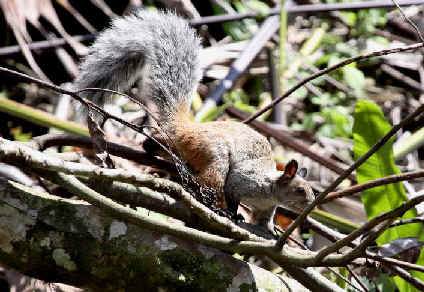 Mammals
Mammals
and
Some Other Wildlife
in Ecuador
including the
Galapagos Islands
noting those found
during
Focus On Nature Tours
with an (*)
thru 2014
A List Of Ecuador Mammals
compiled by Armas Hill
Upper-right photo: a
WHITE-NOSED COATI
photographed during
the FONT tour in Ecuador in July 2013
Codes:
E: in eastern (Amazonian)
Ecuador
G: in the area of the Galapagos Islands
H: in the Andean highlands
O: offshore in the Pacific Ocean
W: in western Ecuador
(ECr): rare in Ecuador
(ECi): introduced in Ecuador
(ph): species with a photo in the FONT web-site
Links:
Upcoming FONT Birding & Nature Tours in Ecuador
A List of Ecuador Birds, in 4 parts (with some photos)
South American Mammals (with some photos)
A List of South American Butterflies, in 5 parts (with some photos)
Directory
of Photos in this FONT Web-Site

List of Mammals:
Family
DIDELPHIDEA
- Derby's Woolly Opossum ______ W
Caluromys derbianus
The Derby's Woolly Opossum has been classified as a vulnerable
species in Ecuador.
- Brown-eared Woolly Opossum ______
E
Caluromys lanatus
The Brown-eared Woolly Opossum
has been classified as a near-threatened species in Ecuador.
- Bushy-tailed Opossum ______ E
Glironia venusta
The Bushy-tailed Opossum has been
classified as a vulnerable species in Ecuador.
- Water Opossum ______ W
E
Chironectes minimus
- Southern (or Black-eared) Opossum
(*)
______ W E (has also been called Common Opossum)
Didelphis marsupialis
-
Didelphis pertnigra
- Philander andersoni
- Common Gray Four-eyed Opossum ______ W
Philander opossum
- Brown Four-eyed Opossum ______
Metachirus nudicaudatus
- Micoureus phaeus
- Bare-tailed Woolly Mouse-Opossum
______
Micoureus regina
- Marmosa lepida
- Murine Mouse-Opossum (*) (ph)
______ E
Marmosa murina
Another name for Marmosa murina
is the Linnaeus' Mouse-Opossum.

A Murine Mouse-Opossum photographed during a FONT
tour
- Robinson's Mouse-Opossum ______
W
Marmosa robinsoni
- Red Mouse-Opossum ______ E
Marmosa rubra
- Tschudi's Slender Mouse-Opossum
______ W E
Marmosops impavidus
Tschudi's Slender Mouse Opossum
has been classified as a near-threatened species in
Ecuador.
- Cerro Neblina Slender Mouse-Opossum
______
Marmosops neblina
- White-bellied Slender Mouse-Opossum
(*)
______ E
Marmosops noctivaga
- Monodelphis adusta
Family CAENOLESTIDAE
- Gray-bellied Shrew-Opossum ______
H(south)
Caenolestes caniventer
- Andean Shrew-Opossum ______ H(south)
Caenolestes condorensis
The Andean Shrew-Opossum is endemic to Ecuador. Although
not classified as threatened, it is rare and poorly known.
- Northern Shrew-Opossum ______ H(north)
Caenolestes convelatus
Although not classified as threatened, the Northern Shrew-Opossum
is rare and poorly known.
- Dusky Shrew-Opossum ______ H
Caenolestes fuliginosus
Family DASYPODIDAE
- Nine-banded Long-nosed Armadillo (ph)
______ W E
Dasypus novemcinctus
- Great Long-nosed Armadillo ______
E
Dasypus kappleri
- Northern Naked-tailed Armadillo
______ W(north)
Cabassous centralis
The Northern Naked-tailed Armadillo has been classified as a near-threatened
species in Ecuador.
- Southern Naked-tailed Armadillo
______ E
Cabassous unicinctus
- Giant Armadillo (ph) ______
E
Priodontes maximus
The Giant Armadillo has been classified as a vulnerable species in Ecuador.
Family CYCLOPEDIDAE
- Silky Anteater ______ W E
Cyclopes didactylus
Family MYRMECOPHAGIDAE
- Giant Anteater (ph)
______ E
Myrmecophaga tridactyla
The Giant Anteater has been classified as a near-threatened
species in Ecuador.
- Northern Tamandua (ph) ______
W
Tamandua mexicana
- Southern Tamandua (*) ______
E (has also been called Collared Anteater)
Tamandua tetradactyla
Family MEGALONYCHIDAE
- Southern Two-toed Sloth ______
E
Choloepus didactylus
- Hoffmann's Two-toed Sloth (ph)
______ W
Choloepus
hoffmanni
Family BRADYPODIDAE
- Brown-throated Three-toed Sloth (ph) ______
W E
Bradypus variegatus
Family LEPORIDAE
- Tapiti (or Brazilian Rabbit)
(*) ______ W H E
Sylvilagus brasiliensis
Family SCIURIDAE
- Amazon Dwarf Squirrel (*) ______ E
Microsciurus flaviventer
- Western Dwarf Squirrel ______
W
Microsciurus mimulus
- Northern Amazon Red Squirrel (*)
______ E
Sciurus igniventris
- Red-tailed Squirrel ______ H W
Sciurus granatensis
- Southern Amazon Red Squirrel (*)
(ph) ______ E
Sciurus spadiceus
- Guayaquil Squirrel (*) (ph) ______
W
Sciurus stramineus

A Guayaquil Squirrel photographed during the FONT Ecuador Tour
in July 2013
(photo by Marie Gardner)


 Mammals
Mammals
![]()







